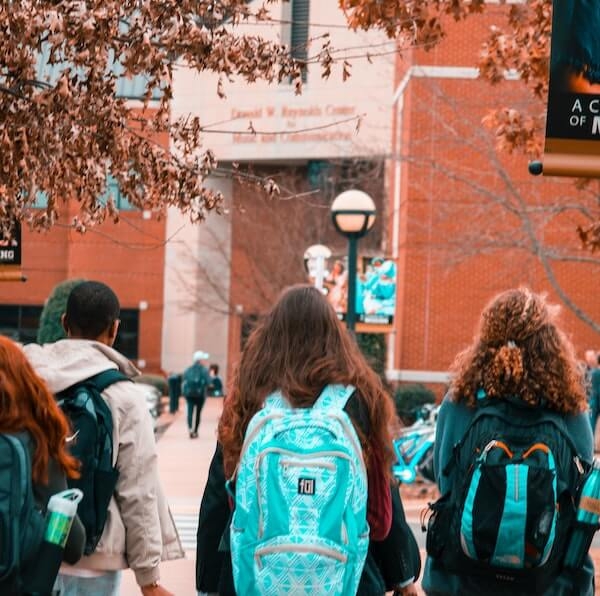The pandemic has taken a toll on student well-being as well as their sense of belonging, and 41% of high school students say the events of the past two years made them feel less connected to peers and teachers.
With enrollment numbers down and mental health concerns on the rise ahead of the new academic year, building a strong school community and support network for students in need is more important than ever. K-12 administrators who are looking to improve both student well-being and learning outcomes are taking a careful look at the metric of “belonging” and finding ways to add social emotional learning skills like social awareness and relationship-building into curricula and programming.
Qualtrics asked more than 1,000 high school students in the U.S. how connected they feel to peers, teachers and staff members at their school, and how that impacts them. Here’s what they had to say:
High school students struggle to feel like they belong
When compared to college students, high school students report much lower levels of belonging at school. In particular, public high school students, students experiencing financial insecurity and female students struggle the most.
Comparisons to college:
- Only 51% of high school students feel like they belong at their school vs. 81% of college students
- 52% of high school students feel like they can be themselves at school vs. 83% of college students
- 56% of high school students are satisfied with their overall experience at school vs. 86% of college students
Who’s at risk:
- Sense of belonging is lower at traditional public schools than private schools and charter schools (48% vs. 59%; 48% vs 57%)
- Sense of belonging is lower for students who participate in free or reduced price lunch programs (49% vs 58%)
- Sense of belonging is lower for female students than male students (50% vs 58%)
- Sense of belong is lower for students who changed high schools after the ninth grade than for those who did not (40% vs 53%)
Sense of belonging is associated with retaining students through graduation
Student sense of belonging has important implications for the student experience and is associated with key indicators of student success including overall satisfaction, likelihood to graduate from their current high school and their likelihood to recommend their school to a friend.
High school students who feel like they belong are more likely to:
- Be glad they attend their school (83% vs 32%)
- Be satisfied with their experience with their school (79% vs 31%)
- Stay through graduation at their current school (93% vs 84%)
- Recommend their school (31% vs 5%)
The top three reasons students say they don’t plan to graduate from their current high school (excluding moving) are:
- This school is not a good fit for me (38%)
- I don’t feel connected to the teachers (28%)
- I don’t feel welcome here (25%)
Students need freedom to be themselves at school
One of the key drivers of sense of belonging is students feeling like they can be themselves at school. Inclusivity and a welcoming environment for all students is critical to improving levels of belonging.
High school students who feel like they belong are more likely to:
- Feel like they can be themselves at school (70% vs 32%)
- Say their school is welcoming (77% vs 38%)
- Be involved in non-academic activities, such as sports (80% vs 67%)
- Feel connected to others students (79% vs 46%)
- Feel connected to a teacher (72% vs 55%)
- Feel connected to a staff member (55% vs 30%)
Bullying is prevalent, but many students aren’t comfortable talking about it
More than a quarter (26%) of current high school students say they have personally been the victim of bullying at school and even more (51%) say they have witnessed bullying. But a large percentage of students aren’t comfortable talking about it with teachers.
- Just 34% of high school students would be comfortable going to a teacher or adult at school if they were being bullied
- 49% would be comfortable going to a teacher or adult at school if someone else was being bullied
The most common types of bullying students say they have witnessed are:
- 1) Name-calling or other verbal abuse
- 2) Spreading rumors
- 3) Exclusion
- 4) Cyber bullying, including spreading personal or explicit content online
Support from peers shows room for improvement
A majority of high school students are confident they can go to peers for academic help, like asking a question about an assignment, but less than half (38%) feel like they can count on other students to help them make friends.
- 56% of students are confident they could call or text another student if they had a question about an assignment
- 55% of students are confident they could get notes from another student if they miss class
- 41% of students are confident they could find another student to study with
- 50% of students are confident they could develop personal relationships with other students
- 40% are confident they could go to another student for emotional support
- 38% are confident they could count on other students to help find people they might want to be friends with
Students aren’t comfortable discussing personal problems with teachers & staff
It’s vital that students have not only peers to turn to when they need help, but trusted adults at school as well. High school students are more comfortable going to the teachers than the staff at their schools.
Teachers:
- 66% of students would be comfortable if they had to talk to a teacher about an academic problem
- 32% would be comfortable if they had to talk to a teacher about a personal problem
- 50% would be comfortable seeking help from a teacher outside of class time (e.g., before school, during a free period) if they had a reason
- 39% are confident that a teacher would be sensitive to their difficulties if they shared them
Staff:
- 56% of students would be comfortable if they had to talk to a staff member about an academic problem
- 25% would be comfortable if they had to talk to a staff member about a personal problem
- 44% are confident a staff member would take the time to talk to them if they needed help
- 37% are confident a staff member would be sensitive to their difficulties if they shared them
Learn more about XM for Education
Methodology
This study was fielded between May 20, 2022 and June 1, 2022. Respondents were identified through a panel and considered eligible if they were a 14-19 year old high school student living in the United States and enrolled at a traditional public, public charter, or private or religious school. Respondents who did not pass quality standards were removed. The total number of respondents is 1,039.



